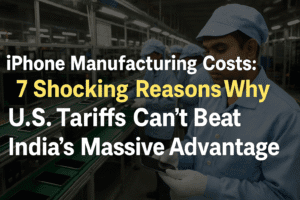iPhone Manufacturing Costs: 7 Shocking Reasons Why U.S. Tariffs Can’t Beat India’s Massive Advantage
Despite former U.S. President Trump’s proposed 25% tariff on India-assembled iPhones, a Global Trade Research Initiative (GTRI) report reveals these devices would still reach American consumers cheaper than if produced domestically. The reason lies in stark labor cost disparities: Indian workers earn just $225–$250 monthly—13 times less than U.S. counterparts—keeping assembly costs at $30 per unit versus a 300–400% spike stateside. Even with tariffs, India’s wage advantage, coupled with its Production-Linked Incentives (offering 4–6% rebates), offsets penalties.
Apple’s profit margins, reliant on global supply chains (70% imported parts), would plummet if U.S. assembly replaced imports, risking price hikes or market share loss. Ultimately, tariffs fail to dismantle India’s fiscal edge, underscoring how modern tech manufacturing thrives on globalized networks, not punitive trade measures.

iPhone Manufacturing Costs: 7 Shocking Reasons Why U.S. Tariffs Can’t Beat India’s Massive Advantage
Even as former U.S. President Donald Trump revives threats to impose a 25% tariff on India-made iPhones, a new analysis reveals a stark truth: Apple’s iconic device could still land on American shelves cheaper when produced in India versus domestically. The Global Trade Research Initiative (GTRI) report unpacks this paradox, highlighting how global supply chains and wage disparities tilt the scales in India’s favor. Here’s what it means for consumers, Apple, and the future of tech manufacturing.
The Math Behind iPhone Costs: A Global Puzzle
While a $1,000 iPhone is often seen as a symbol of American innovation, its production is a multinational effort. The GTRI breaks down the financial ecosystem behind each device:
- U.S. firms like Qualcomm and Broadcom supply $80 in components.
- South Korea adds $90 for displays and memory chips.
- Japan contributes $85 for advanced camera modules.
- Taiwan handles chip fabrication.
- China and India assemble devices but earn just $30 per unit (3% of the retail price).
This distribution shows Apple’s reliance on global expertise—and why shifting production entirely to the U.S. isn’t straightforward.
Labor Costs: India’s Unbeatable Advantage
The GTRI identifies labor costs as the linchpin. Indian factory workers earn roughly $225–$250 monthly, compared to $2,900+ for U.S. technicians—a 13x difference. Assembling an iPhone in India costs Apple $30 per unit; replicating this in the U.S. could spike expenses by 300–400%. Even with a 25% tariff, India’s labor savings would offset the penalty, keeping U.S. retail prices competitive.
Why Tariffs Alone Can’t Reshape Supply Chains
- Profit Margins at Risk: Moving assembly to the U.S. could slash Apple’s profit per iPhone from $200+ to just $60, forcing price hikes to maintain margins—a risky move in a price-sensitive market.
- India’s Incentives: India’s Production-Linked Incentive (PLI) scheme offers manufacturers like Apple 4–6% cashback on incremental sales, further reducing costs.
- Component Ecosystem: Over 70% of iPhone parts are imported, meaning U.S. assembly would still depend on global suppliers, negating “self-reliance” claims.
The Bigger Picture: Trade Wars and Tech’s Tightrope
Trump’s tariff threats reflect a broader push to repatriate manufacturing, but the GTRI warns of unintended consequences:
- Consumer Impact: iPhones could cost $150–$200 more if U.S. assembly replaces imports, even without tariffs.
- China+1 Strategy: Apple’s India shift isn’t just about costs—it’s hedging geopolitical risks by diversifying beyond China. Tariffs won’t undo this calculus.
- Global Ripple Effects: Higher U.S. prices could drive consumers toward Android alternatives, eroding Apple’s market share.
What This Means for the Future
While tariffs might score political points, they ignore the realities of modern tech manufacturing. India’s cost edge isn’t just about cheap labor—it’s about integrated policies, scale, and a growing tech workforce. For Apple, the choice isn’t between India and the U.S., but between profitability and symbolism.
As trade tensions simmer, one truth remains: In a hyper-globalized world, punitive tariffs are a blunt tool against finely tuned supply chains. The iPhone’s journey from Mumbai to Miami underscores why.
Lower labor costs, government incentives, and an entrenched global supplier network make India a fiscal fortress for Apple—one that even 25% tariffs struggle to breach. For consumers, that means iPhones are likely to stay affordable, no matter where they’re assembled.
You must be logged in to post a comment.